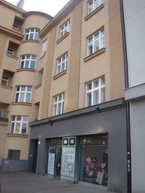Important events
Dwelling house with restaurant, shops according design by Josefa Poskočil.
People
History
House no. 15 in Zelená street (no. 1084) was built in 1929 and the building was designed by Josef Poskočila. Apart from flats, shops and a restaurant, there was a gym in the basement which was also used for theatre performances – the hall had a flat floor and on the side facing the yard was an elevated stage behind the right-angular portal. Around 1990 there was a shop with lecture books of the Czech Technical University; in 1992 the hall was adapted for theatre purposes (the project engineer is not known). The arrangement was changed – a nine level seating platform for about hundred visitors was built above the stage and the original floor of the hall was used for events.
The first performance took place on 14 October 1992 (Matěj Kopecký, Johanes doktor Faust). It was performed by students of DAMU Alternative and Puppet Theatre Group led by the director Jan Borna who became the art director of the new stage in 1993. The theatre was then a part of the Cultural Centre of Prague 6, later called Spektrum K – an association of cultural centres of Prague 6. It was not until 1993 that the stage gained the status of a professional theatre. In September 1996, Borna transferred to the newly established theatre Divadlo v Dlouhé and Miroslav Krobot, who then finished his six-year contract with the National Theatre, became the art director of Dejvické divadlo. Since its establishment, the director of the theatre is Eva Měřičková. The process of transforming Dejvické divadlo from an allowance organization of Prague 6 City Council to a non-profit organization was completed in June 2004.
The reconstruction of the hall was based on an architectural study submitted in three versions by a group of architects led by Oldřich Hájek in December 1999. The reconstruction was implemented according to the selected project and started in April 2001, and was completed in October of the same year. On 16 November the first performance took place in the newly refurbished theatre premises. It was the Tales of Common Insanity by Petr Zelenka directed by the playwright himself. The space of the right-angled theatre hall divided by four round pillars into three bodies now has original layout. The stage with the dimensions 5×7m is situated towards the yard. Very important is the proscenium stage which can be dismantled and extends the stage by three metres; there is only one trap (1×1 metre). The nine-level auditorium with the overall seating capacity of 125 is situated closer to the street. The stage and the auditorium form an integral unity in terms of space; the walls painted in dark colours contrast the light-grey seat cover.
Simultaneously with the reconstruction of the main hall, the theatre facilities were also expanded – more operational rooms were built and the space for visitors gained a new elegant design. The glass portal in the front façade provides the access to the entrance foyer with box offices and a cloak room. The light-brown wooden facing used on major interior elements dominate the foyer; other surfaces are painted in grey, white and black. The foyer along the theatre hall, which descends into the newly attached bar in the basement, is decorated with similar colours. A large window installed in the front wall of the foyer opens into a spacious air shaft with a rock-garden covered with a rich growth.
Tags: Neoclassicism, Interwar period, Cubism
Author: Jiří Hilmera
Jiří Hilmera:
Karlovy Vary City Theatre, Minor Theatre, Vinohrady Theatre, Theatre in Celetna, Silesian Theatre Opava, State Opera, Estates Theatre, Jára Cimrman Žižkov Theatre, Theatre without a Balustrade, Kalich Theatre, Costanza e Fortezza, The Ungelt Theatre, Theatre in Mozarteum, Municipal Theatre Mariánské Lázně, Phasma Dionysiacum Pragense, J. K. Tyl Theatre Třeboň, Theatre in the Wallenstein Palace Garden, The Realm of Puppets, Braník Theatre, Dejvické Theatre, Stone Theatre, Theatre Na Jezerce, Theatre Na Prádle, Ponec Theatre, Theatre in Dlouhá, Strašnice Theatre, Semafor, Under Palmovka Theatre, Ypsilon Studio, Competition Hradec Králové, Ostrava competition for a building of opera 1958-1959, Theatre designs by Josef Gočár, Beskydy Theatre CompetitionTranslator: Zdislava Kratěnová
Zdislava Kratěnová:
Theatre in Celetna, State Opera, Town Theatre Krnov, Municipal Theatre of K. H. Mácha Litoměřice, Tyl's House in Polička, Hybernia Theatre, Švanda's Theatre in Smíchov, Mahen Theatre Brno, ABC Theatre, The Realm of Puppets, Klicpera's theatre Hradec Králové, Dejvické Theatre, Theatre Na Jezerce, Theatre Na Prádle, Ponec Theatre, Theatre in Dlouhá, Under Palmovka Theatre, Palace Theatre Hluboká nad VltavouAdditional information
No information has yet been entered
Add information


























